by Todd Walker
The power of simple machines, smartly employed, are capable of moving most anything. Over the years I helped my daddy move really heavy stuff in his plumbing/welding business and on our farm. He once moved and installed a new 3,000 gallon metal water tank at our elementary school using only ropes, pulleys, and levers… by himself.
Daddy didn’t possess superhuman strength, he simply understood the power of simple machines.
Give me a lever long enough and a fulcrum on which to place it, and I shall move the world.
Archimedes
I first discovered this ingenious flip-flop winch from a YouTube demonstration by Mors Kochanski, the Godfather and author of Bushcraft. A search of flip-flop winches on YT will garner several clips demonstrating the power of using two logs and some rope. So why would I add my video to mix? Because it’s only theory until you put it into action by Doing the Stuff!
The flip-flop winch combines two simple machines, lever and pulley (wheel and axle), as a force multiplier to free vehicles stuck in the mud, safely dislodge hang-ups when felling trees, and/or move heavy rocks. I decided to pull my truck up a slight incline in a field.
Flip Flop Winch
In an emergency vehicle kit, weight and space are not an issue – unless you tool around in a Smart Car. For this winch, all you need are two logs and some rope. Of course, you’re not hauling eight foot logs in your vehicle. You will have to cut those with your truck ax or takedown bucksaw.
Material and Tools
- Ax or Saw – cut two logs about 8 feet in length
- Rope – non-elastic is preferable for safety reasons
- Cordage – enough to make two loops about 1 foot in diameter
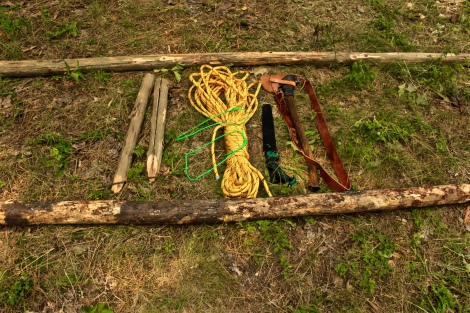
L to R: Green paracord loops, 100′ of rope, truck saw, truck ax. Top pole – lever pole. Bottom pole – pulley pole.
Cut Two Poles
You’ve hit a ditch or snow bank (rarely happens in Georgia) in the hinter-boonies and need to get unstuck. Reach into your vehicle emergency kit and fetch your saw or ax. You have an emergency vehicle kit, right? Be sure to add 100 feet of strong rope to the kit if you haven’t already. A tow strap won’t be useful with this winch unless it’s really long.
Scout for a straight tree (dead or live – it’s an emergence) to cut. Anything between 4 to 6 inches in diameter is suitable. Cut two lengths in the 8 foot range. De-limb the poles by chopping any branches off with your sharp truck ax. You can saw them off but proper ax-manship makes quick work of the de-limbing. This process is best done by cutting from the trunk end to the top end of the pole. Keep the pole between your body and the moving ax.
Lever and Pulley Pole
Now that you’ve got two poles, one will be used as the “lever pole” and the other will be your “pulley pole.” I noticed in my video that I called the drum pole a “barrel” pole interchangeably. In this written tutorial, I will use “pulley pole” to hopefully clear up the verbiage. The terminology is not that important. What you need to know is that the pulley pole is where the rope will coil similarly to that of a modern come-along.
A larger diameter pulley will winch more rope with each revolution. The pulley pole I used was a standing dead pine which was a bit lightweight for the job. I was forced to drive two stakes in the ground to prevent the pulley pole from swinging in towards the tensioned rope in our video. With two people available, the stakes wouldn’t be necessary. A heavier pulley pole will solve the issue as well. I wanted to simulate and experiment with the lowest quality wood I could scavenge. The lever was a smaller dead cedar but the most solid of the two poles.
Locate an Anchor
The base of a live tree is perfect. A dead tree is not a good candidate. You’ll risk toppling the tree down if the object you’re pulling is really stuck or heavy. Wrap the rope around the base of the anchor twice and tie it off with a tensioning knot.
Ideally, you want the anchor point and the object you’re pulling to form a straight line sighted down the rope.
2 Rigging the Systems
Midway between the anchor and object lay the two poles perpendicular to one another. Run the rope on top of the pulley pole about a foot from the larger end of the pole. Pull the rope back under the pole to form a loop. Insert the lever pole into the loop from the side of the pulley pole where the loop is formed. Give yourself about a foot of lever sticking through the loop.
There are two methods of rigging the winch. Rig 1: One causes the rope to coil on both side of the pulley pole where the lever pole crosses (demonstrated on the video). Rig 2: This technique causes the rope to spool on one side of the pulley pole. I’ve found that the latter method causes less side-to-side torque since the rope remains in a straight line.
With the winch rigged, pull the slack out of the line and tie to the object you’re pulling. Another tension knot will work.
Start the Flip-Flop
Flip the lever pole up and over the pulley pole. Once on the ground, check the first wrap on the pulley pole. This is the time to straighten the loops around the pulley before real tension begins. Try to keep the rope from spooling on top of the previous coils as this may weaken the rope. With each flip-flop, the rope will begin coiling on the pulley pole.
Note: I’ve watched others spool rope on one side of the pulley pole only. This technique decreases the swing of the pulley pole towards the rope under tension. To use this method, place the rope attached to the anchor and the object on the same side of the lever pole before flip-flopping.

Notice how the rope coils to one side of the lever pole (Rig 2). With the rope in line, the pulley pole is less likely to torque in towards the tow rope..
Now, flop the pulley pole over the rope for the next flip of the lever. If the pulley pole was magically suspended off the ground, no flop would be required. This would become a Spanish windlass. You’d simple spin the lever around a wheel and axle. The earth prevents this continuous spin. But the ground is what keeps the system from unraveling. The flop of the pulley pole is necessary for the lever to make another 180 degree revolution.
Continue this flip-flop action until the object is freed. Six full revolutions around the pulley is what it took to inch my truck up the incline to level ground in the video.
Flip-Flop Tips When Alone
If you practice the technique with rope coiling on the pulley pole on both sides of the lever, you’ll find that the pulley has a tendency to swing in towards the rope as tension increases. My fix was to drive two stakes on opposite sides of the rope where the pulley pole lands on each flop. If the ground is too hard for stakes, a heavy rock or object may prevent the slide. As mentioned above, a heavier pulley pole would decrease the chances of this happening.
Experimenting with the rope spooling on one side of the pulley pole remedied the torque issues. I recommend using this method (Rig 2) vs. the rope spooling on opposite sides of the lever pole (Rig 1).
Also, under tension, the lever pole can rise off the ground with either method. Attach a loop of cordage on the tow rope where the flipped lever lands. Slide the loop over the lever on each flip once a good amount of tension is present.
Disconnecting the Rig
Obviously, once a vehicle is freed, the rope is no longer under tension. However, when pulling a tree or rock, tension can be released by reversing direction of the flip-flop. Once tension is removed, the spooled line can be handled safely.
Safety Concerns
There are inherent dangers when tension is applied to a rope or cable. If the rope has elasticity and snaps, the potential energy turns to kinetic energy moving like a slingshot or bow and arrow in opposite directions. Use rope without elasticity, nicks, abrasions, and a working load suitable for the task.
If you’re alone, you must cross over the rope in this process. Minimize the risk from flying rope by laying a heavy coat or blanket (if available) on the rope at both ends. You can also lay branches on the line if no blanket is available. With two people, nobody has to step over the taut line.
Another safety precaution is to wear leather gloves and eye protection. A smart thing to have is a knife handy to cut the rope if you somehow manage to get a hand pinched between the rope and pulley. Not sure how that might happen but better safe than sorry.
This powerful simple machine takes practice to perform properly. With a minimum of tools and some rope, the flip-flop winch can be a life saver on the homestead or in the backcountry. Add it to your preparedness toolbox. Give it a try and share your results.
Keep Doing the Stuff of Self-Reliance,
Todd
P.S. – You can also keep up with the Stuff we’re Doing on Twitter, Pinterest, Google +, YouTube, Instagram, and Facebook… and over at the Doing the Stuff Network.
P.P.S – If you find value in our blog, Dirt Road Girl and I would appreciate your vote on Top Prepper Sites! You can vote daily by clicking here or on the image below. Check out all the other value-adding sites while you’re there…
Thanks for Sharing the Stuff!
Copyright © by Survival Sherpa: In light of the recent theft of all my content by a pirate site, my sharing policy has changed. I do not permit the re-posting of entire articles from my site without express written consent by me. My content on this site may be shared in digital form (200 words or less) for non-commercial use with a link back (without no-follow attribute) to the original article crediting the author. All photos, drawings, and articles are copyrighted by and the property of Survival Sherpa. You are more than welcome to share our photos and articles on social media for educational purposes as long as you link back to the original article/photo with credit to the author.
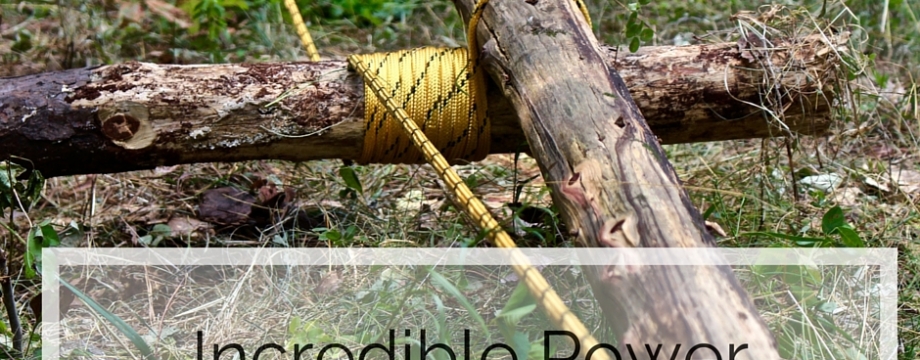
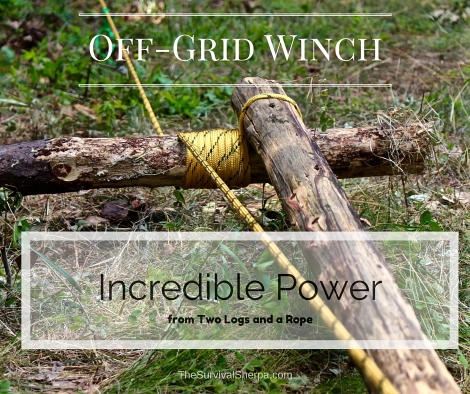
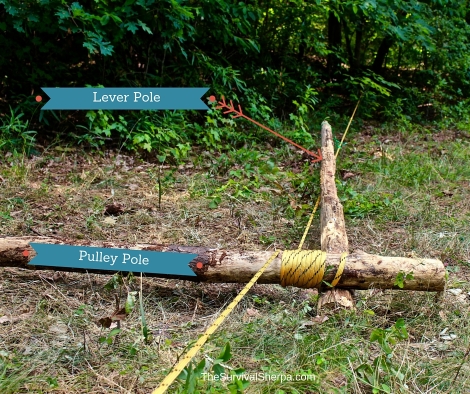



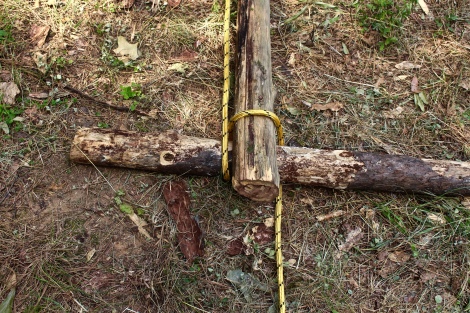
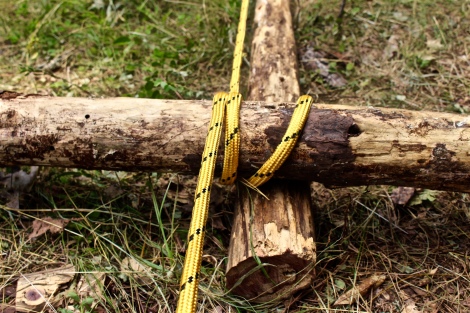
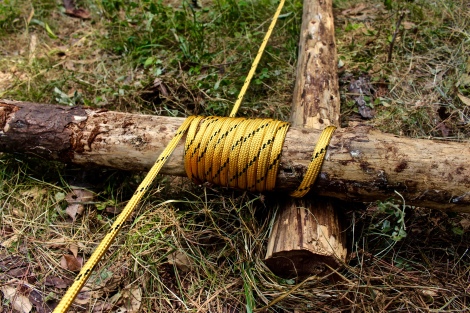









I like the Rome empire way of doing thing off the grid.
By the way when you make a “U” shape in a length of rope it is always call a bright not a loop.
LikeLike
Pingback: 6 Simple Machines for Smart Preppers | Survival Sherpa
Pingback: The Top 7 Survival Sherpa Articles of 2016 | Survival Sherpa
Very ingenious idea learn something every day
Thanks
LikeLike
I like what I read but I still can’t visualize what I’m doing.
A video would have helped.
LikeLike
I put the video of the winch in the article. It’s also on my channel with by the same name, Bob. https://youtu.be/QFDGGht3CQU
LikeLike
Different tools for getting out of a jamb, loved it,
LikeLike
Many thanks, Gene!
LikeLike
Love the hundreds of ways a rope can be used, with a good rope and enough hitches tied into it and used as pulleys you don’t even need the logs.
LikeLike
Hey Todd, very nice explanation here. I can think of multiple uses for this on the homestead.
I’m curious about the rope you are using, what type/brand do you prefer for these tasks? I have limited experience with ropes, and the stuff I use currently is not the best quality. I don’t need a Cadillac, but I’m not happy with the Yugo either…LOL.
Thanks again
LikeLike
Thanks, Dave! The rope pictured is a cheap rope from Home Depot. It’s got more elasticity than I’d like but can’t afford really good rope. This one works though. I’ve dislodged trees and pulled my truck in demos with this same rope several times and it holds up pretty well. Good kernmantle rope is expensive. I don’t use my rope for search and rescue or climbing so I stick with what works for me.
LikeLike
Ingenious. Very clear presentation greatly appreciated
LikeLike
Many thanks for the feedback.
LikeLike
Great demo. Very useful knowledge
LikeLike
Thank you, Lindsey, for the feedback!
LikeLike
GREAT
LikeLike
Pingback: Gear Review: Camping Gear Folding Pocket Chainsaw & Fire Starter Kit By SUMPRI - Dave's Homestead
Pingback: How to Mitigate the 5 Deadly Sins of Ax-Work | Survival Sherpa
looks great; in the woods by myself
LikeLike
Pingback: Introducing the Survival Sherpa School | Survival Sherpa